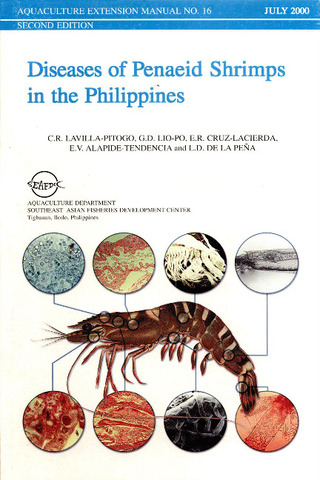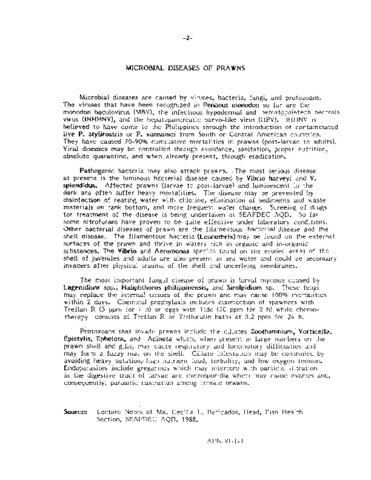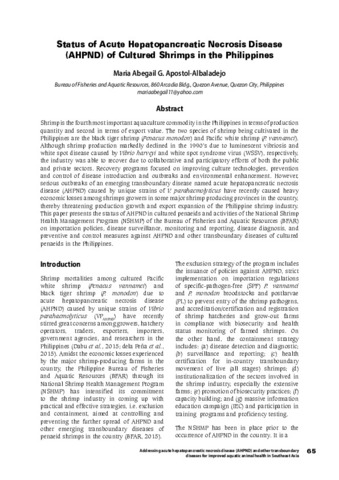| dc.contributor.author | Parado-Estepa, Fe D. | |
| dc.contributor.author | Honculada-Primavera, Jurgenne | |
| dc.contributor.editor | Juario, Jesus V. | |
| dc.contributor.editor | Benitez, Lita V. | |
| dc.date.accessioned | 2011-06-06T02:34:00Z | |
| dc.date.available | 2011-06-06T02:34:00Z | |
| dc.date.issued | 1988 | |
| dc.identifier.citation | Parado-Estepa, F., & Honculada-Primavera, J. (1988). Broodstock management and seed production of Penaeus monodon (Fabricius). In J. V. Juario & L. V. Benitez (Eds.), Perspectives in Aquaculture Development in Southeast Asia and Japan: Contributions of the SEAFDEC Aquaculture Department. Proceedings of the Seminar on Aquaculture Development in Southeast Asia, 8-12 September 1987, Iloilo City, Philippines. (pp. 149-168). Tigbauan, Iloilo, Philippines: SEAFDEC, Aquaculture Department. | en |
| dc.identifier.isbn | 971851113X | |
| dc.identifier.uri | http://hdl.handle.net/10862/144 | |
| dc.description.abstract | Research on the maturation of Penaeus monodon at AQD has focused on three broad areas, namely, reproductive biology and ecology, induced maturation and broodstock management. Studies on reproductive biology provided information on the life cycle, ovarian maturation stages, courtship and mating behavior, minimum size at sexual maturation (sperm occurrence, first spawning), and morphological egg types. Induced maturation has mainly been done through the eyestalk ablation method. Nutritional and environmental parameters were studied to enhance reproductive performance or as an alternative to ablation. Pond-reared and wild broodstock sources and marine pen and land-based tanks as maturation systems were also tested and compared. Size, shape, color, substrate material and other aspects of tank design and construction, sex ratio, stocking density, water management, and other parameters of the management system were also studied and refined.
Early techniques in larval and postlarval rearing of P. monodon at AQD were based on the community culture method of growing natural food in larval tanks. However, low and inconsistent survival led to a shift in rearing methods toward pure phytoplankton culture grown in separate tanks as food for the larvae. Henceforth, refinement of rearing methods have been conducted to improve larval survival through effective water management, nutrition, and disease control. Efforts are continuously being geared toward making the technology affordable to Filipino farmers. | en |
| dc.language.iso | en | en |
| dc.publisher | Aquaculture Department, Southeast Asian Fisheries Development Center | en |
| dc.subject | Penaeus monodon | |
| dc.subject | Philippines | en |
| dc.title | Broodstock management and seed production of Penaeus monodon (Fabricius) | en |
| dc.type | Conference paper | en |
| dc.citation.spage | 149 | |
| dc.citation.epage | 168 | |
| dc.subject.asfa | Courtship | en |
| dc.subject.asfa | sexual behaviour | en |
| dc.subject.asfa | shrimp culture | en |
| dc.subject.asfa | husbandry diseases | en |
| dc.subject.asfa | pond culture | en |
| dc.subject.asfa | disease control | en |
| dc.subject.asfa | survival | en |
| dc.subject.asfa | life cycle | en |
| dc.subject.asfa | induced ovulation | en |
| dc.subject.asfa | seed production | en |
| dc.subject.asfa | Larval development | en |
| dc.subject.asfa | environmental factors | en |
| dc.subject.asfa | eyestalk extirpation | en |
| dc.subject.asfa | rearing techniques | en |
| dc.subject.asfa | sexual maturity | en |
| dc.subject.asfa | reproductive cycle | en |
| dc.subject.asfa | cage culture | en |
| dc.subject.asfa | feeding experiments | en |
| dc.subject.asfa | reproductive behaviour | en |
| dc.subject.asfa | parasitic diseases | en |
| dc.subject.asfa | breeding stock | en |
| dc.subject.asfa | mortality causes | en |
| dc.subject.asfa | aquaculture techniques | en |
| dc.subject.asfa | crustacean larvae | en |
| dc.citation.conferenceTitle | Seminar on Aquaculture Development in Southeast Asia, 8-12 September 1987, Iloilo City, Philippines | en |
| dc.subject.scientificName | Penaeus monodon | |



